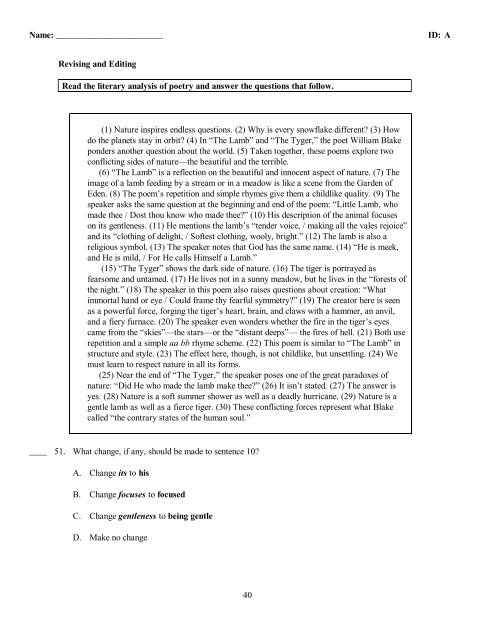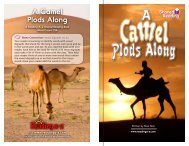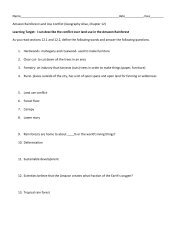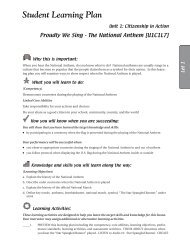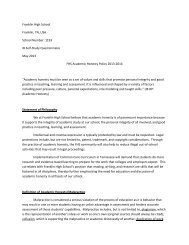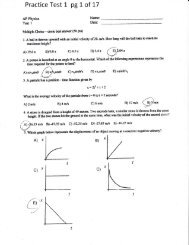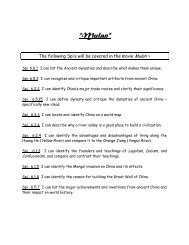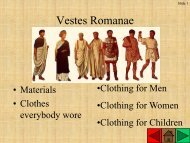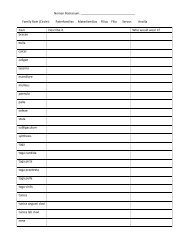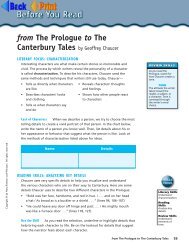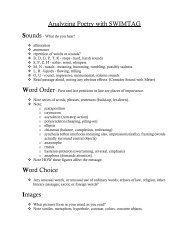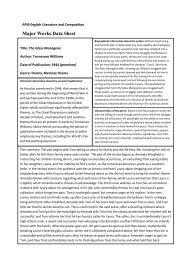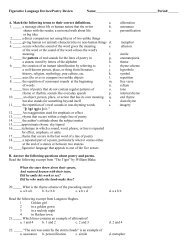ExamView - CCE Practice Test - Williamson County Schools
ExamView - CCE Practice Test - Williamson County Schools
ExamView - CCE Practice Test - Williamson County Schools
You also want an ePaper? Increase the reach of your titles
YUMPU automatically turns print PDFs into web optimized ePapers that Google loves.
Name: ________________________<br />
ID: A<br />
Revising and Editing<br />
Read the literary analysis of poetry and answer the questions that follow.<br />
(1) Nature inspires endless questions. (2) Why is every snowflake different? (3) How<br />
do the planets stay in orbit? (4) In “The Lamb” and “The Tyger,” the poet William Blake<br />
ponders another question about the world. (5) Taken together, these poems explore two<br />
conflicting sides of nature—the beautiful and the terrible.<br />
(6) “The Lamb” is a reflection on the beautiful and innocent aspect of nature. (7) The<br />
image of a lamb feeding by a stream or in a meadow is like a scene from the Garden of<br />
Eden. (8) The poem’s repetition and simple rhymes give them a childlike quality. (9) The<br />
speaker asks the same question at the beginning and end of the poem: “Little Lamb, who<br />
made thee / Dost thou know who made thee?” (10) His description of the animal focuses<br />
on its gentleness. (11) He mentions the lamb’s “tender voice, / making all the vales rejoice”<br />
and its “clothing of delight, / Softest clothing, wooly, bright.” (12) The lamb is also a<br />
religious symbol. (13) The speaker notes that God has the same name. (14) “He is meek,<br />
and He is mild, / For He calls Himself a Lamb.”<br />
(15) “The Tyger” shows the dark side of nature. (16) The tiger is portrayed as<br />
fearsome and untamed. (17) He lives not in a sunny meadow, but he lives in the “forests of<br />
the night.” (18) The speaker in this poem also raises questions about creation: “What<br />
immortal hand or eye / Could frame thy fearful symmetry?” (19) The creator here is seen<br />
as a powerful force, forging the tiger’s heart, brain, and claws with a hammer, an anvil,<br />
and a fiery furnace. (20) The speaker even wonders whether the fire in the tiger’s eyes<br />
came from the “skies”—the stars—or the “distant deeps”— the fires of hell. (21) Both use<br />
repetition and a simple aa bb rhyme scheme. (22) This poem is similar to “The Lamb” in<br />
structure and style. (23) The effect here, though, is not childlike, but unsettling. (24) We<br />
must learn to respect nature in all its forms.<br />
(25) Near the end of “The Tyger,” the speaker poses one of the great paradoxes of<br />
nature: “Did He who made the lamb make thee?” (26) It isn’t stated. (27) The answer is<br />
yes. (28) Nature is a soft summer shower as well as a deadly hurricane. (29) Nature is a<br />
gentle lamb as well as a fierce tiger. (30) These conflicting forces represent what Blake<br />
called “the contrary states of the human soul.”<br />
____ 51. What change, if any, should be made to sentence 10?<br />
A. Change its to his<br />
B. Change focuses to focused<br />
C. Change gentleness to being gentle<br />
D. Make no change<br />
40


